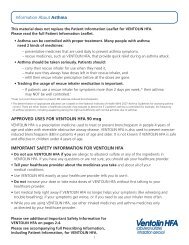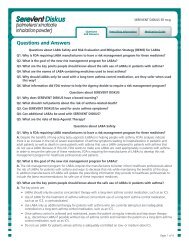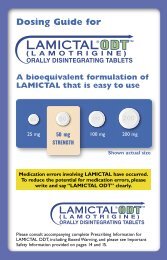FDA Approved Long-Acting Beta Agonists - GSK Source
FDA Approved Long-Acting Beta Agonists - GSK Source
FDA Approved Long-Acting Beta Agonists - GSK Source
You also want an ePaper? Increase the reach of your titles
YUMPU automatically turns print PDFs into web optimized ePapers that Google loves.
ADVAIR DISKUS ® 100/50 (fluticasone propionate 100 mcg and salmeterol 50 mcg inhalation powder)<br />
ADVAIR DISKUS ® 250/50 (fluticasone propionate 250 mcg and salmeterol 50 mcg inhalation powder)<br />
ADVAIR DISKUS ® 500/50 (fluticasone propionate 500 mcg and salmeterol 50 mcg inhalation powder)<br />
Table 3. Overall Adverse Reactions With ≥3% Incidence With ADVAIR DISKUS<br />
250/50 in Patients With Chronic Obstructive Pulmonary Disease Associated With<br />
Chronic Bronchitis (cont.)<br />
ADVAIR Fluticasone<br />
DISKUS Propionate Salmeterol<br />
250/50 250 mcg 50 mcg Placebo<br />
(N = 178) (N = 183) (N = 177) (N = 185)<br />
Adverse Event % % % %<br />
Non-site specific<br />
Fever 4 3 0 3<br />
Malaise & fatigue 3 2 2 3<br />
Musculoskeletal<br />
Musculoskeletal pain 9 8 12 9<br />
Muscle cramps & spasms 3 3 1 1<br />
In the two 1-year studies, ADVAIR DISKUS 250/50 was compared with salmeterol in 1,579<br />
patients (863 males and 716 females). The mean age of the patients was 65, and the majority<br />
(94%) was Caucasian. To be enrolled, all of the patients had to have had a COPD exacerbation in<br />
the previous 12 months. In this trial, 88% of the patients treated with ADVAIR DISKUS and 86%<br />
of the patients treated with salmeterol reported an adverse event. The most common events that<br />
occurred with a frequency of >5% and more frequently in the patients treated with ADVAIR DISKUS<br />
were nasopharyngitis, upper respiratory tract infection, nasal congestion, back pain, sinusitis, dizziness,<br />
nausea, pneumonia, candidiasis, and dysphonia. Overall, 55 (7%) of the patients treated with<br />
ADVAIR DISKUS and 25 (3%) of the patients treated with salmeterol developed pneumonia.<br />
The incidence of pneumonia was higher in patients over 65 years of age, 9% in the patients<br />
treated with ADVAIR DISKUS compared with 4% in the patients treated with ADVAIR DISKUS less<br />
than 65 years of age. In the patients treated with salmeterol, the incidence of pneumonia was the<br />
same (3%) in both age-groups. [See Warnings and Precautions (5.5.), Use in Specific Populations<br />
(8.5).]<br />
<strong>Long</strong>-Term (3-Year) Trial: The safety of ADVAIR DISKUS 500/50 was evaluated in a randomized,<br />
double-blind, placebo-controlled, multicenter, international, 3-year study in 6,184 adult<br />
patients with COPD (4,684 males and 1,500 females). The mean age of the patients was 65, and the<br />
majority (82%) was Caucasian. The distribution of adverse events was similar to that seen in the<br />
1-year trials with ADVAIR DISKUS 250/50. In addition, pneumonia was reported in a significantly<br />
increased number of patients treated with ADVAIR DISKUS 500/50 and fluticasone propionate<br />
500 mcg (16% and 14%, respectively) compared with patients treated with salmeterol 50 mcg or<br />
placebo (11% and 9%, respectively). When adjusted for time on treatment, the rates of pneumonia<br />
were 84 and 88 events per 1,000 treatment-years in the groups treated with fluticasone propionate<br />
500 mcg and with ADVAIR DISKUS 500/50, respectively, compared with 52 events per 1,000 treatment-years<br />
in the salmeterol and placebo groups. Similar to what was seen in the 1-year studies<br />
with ADVAIR DISKUS 250/50, the incidence of pneumonia was higher in patients over 65 years of<br />
age (18% with ADVAIR DISKUS 500/50 versus 10% with placebo) compared with patients less than<br />
65 years of age (14% with ADVAIR DISKUS 500/50 versus 8% with placebo). [See Warnings and<br />
Precautions (5.5), Use in Specific Populations (8.5).]<br />
Additional Adverse Reactions: Other adverse reactions not previously listed, whether considered<br />
drug-related or not by the investigators, that were reported more frequently by patients<br />
with COPD treated with ADVAIR DISKUS compared with patients treated with placebo include the<br />
following: syncope; ear, nose, and throat infections; ear signs and symptoms; laryngitis; nasal<br />
congestion/blockage; nasal sinus disorders; pharyngitis/throat infection; hypothyroidism; dry eyes;<br />
eye infections; gastrointestinal signs and symptoms; oral lesions; abnormal liver function tests;<br />
bacterial infections; edema and swelling; viral infections.<br />
Laboratory Abnormalities: There were no clinically relevant changes in these trials. Specifically,<br />
no increased reporting of neutrophilia or changes in glucose or potassium was noted.<br />
6.3 Postmarketing Experience<br />
In addition to adverse events reported from clinical trials, the following events have been<br />
identified during worldwide use of any formulation of ADVAIR, fluticasone propionate, and/or salmeterol<br />
regardless of indication. Because they are reported voluntarily from a population of unknown<br />
size, estimates of frequency cannot be made. These events have been chosen for inclusion<br />
due to either their seriousness, frequency of reporting, or causal connection to ADVAIR DISKUS,<br />
fluticasone propionate, and/or salmeterol or a combination of these factors.<br />
Cardiac Disorders: Arrhythmias (including atrial fibrillation, extrasystoles, supraventricular<br />
tachycardia), ventricular tachycardia.<br />
Endocrine Disorders: Cushing’s syndrome, Cushingoid features, growth velocity reduction in<br />
children/adolescents, hypercorticism.<br />
Eye Disorders: Glaucoma.<br />
Gastrointestinal Disorders: Abdominal pain, dyspepsia, xerostomia.<br />
Immune System Disorders: Immediate and delayed hypersensitivity reaction (including very rare<br />
anaphylactic reaction). Very rare anaphylactic reaction in patients with severe milk protein allergy.<br />
Metabolic and Nutrition Disorders: Hyperglycemia, weight gain.<br />
Musculoskeletal, Connective Tissue, and Bone Disorders: Arthralgia, cramps, myositis,<br />
osteoporosis.<br />
Nervous System Disorders: Paresthesia, restlessness.<br />
Psychiatric Disorders: Agitation, aggression, depression. Behavioral changes, including<br />
hyperactivity and irritability, have been reported very rarely and primarily in children.<br />
Reproductive System and Breast Disorders: Dysmenorrhea.<br />
Respiratory, Thoracic, and Mediastinal Disorders: Chest congestion; chest tightness; dyspnea;<br />
facial and oropharyngeal edema, immediate bronchospasm; paradoxical bronchospasm; tracheitis;<br />
wheezing; reports of upper respiratory symptoms of laryngeal spasm, irritation, or swelling<br />
such as stridor or choking.<br />
Skin and Subcutaneous Tissue Disorders: Ecchymoses, photodermatitis.<br />
Vascular Disorders: Pallor.<br />
7 DRUG INTERACTIONS<br />
ADVAIR DISKUS has been used concomitantly with other drugs, including short-acting<br />
beta 2-agonists, methylxanthines, and intranasal corticosteroids, commonly used in patients with<br />
asthma or COPD, without adverse drug reactions. No formal drug interaction studies have been<br />
performed with ADVAIR DISKUS.<br />
7.1 Inhibitors of Cytochrome P450 3A4<br />
Fluticasone propionate and salmeterol, the individual components of ADVAIR DISKUS, are<br />
substrates of CYP3A4. The use of strong CYP3A4 inhibitors (e.g., ritonavir, atazanavir, clarithromycin,<br />
indinavir, itraconazole, nefazodone, nelfinavir, saquinavir, ketoconazole, telithromycin) with<br />
ADVAIR DISKUS is not recommended because increased systemic corticosteroid and increased<br />
cardiovascular adverse effects may occur.<br />
Ritonavir: Fluticasone Propionate: A drug interaction study with fluticasone propionate aqueous<br />
nasal spray in healthy subjects has shown that ritonavir (a strong CYP3A4 inhibitor) can significantly<br />
increase plasma fluticasone propionate exposure, resulting in significantly reduced serum<br />
cortisol concentrations [see Clinical Pharmacology (12.3)]. During postmarketing use, there have<br />
been reports of clinically significant drug interactions in patients receiving fluticasone propionate<br />
and ritonavir, resulting in systemic corticosteroid effects including Cushing’s syndrome and adrenal<br />
suppression.<br />
Ketoconazole: Fluticasone Propionate: Coadministration of orally inhaled fluticasone propionate<br />
(1,000 mcg) and ketoconazole (200 mg once daily) resulted in increased plasma fluticasone<br />
propionate exposure and reduced plasma cortisol area under the curve (AUC), but had no effect on<br />
urinary excretion of cortisol.<br />
Salmeterol: In a drug interaction study in 20 healthy subjects, coadministration of inhaled<br />
salmeterol (50 mcg twice daily) and oral ketoconazole (400 mg once daily) for 7 days resulted<br />
in greater systemic exposure to salmeterol (AUC increased 16-fold and Cmax increased 1.4-fold).<br />
Three (3) subjects were withdrawn due to beta 2-agonist side effects (2 with prolonged QTc and 1<br />
with palpitations and sinus tachycardia). Although there was no statistical effect on the mean QTc,<br />
coadministration of salmeterol and ketoconazole was associated with more frequent increases in<br />
QTc duration compared with salmeterol and placebo administration.<br />
7.2 Monoamine Oxidase Inhibitors and Tricyclic Antidepressants<br />
ADVAIR DISKUS should be administered with extreme caution to patients being treated with<br />
monoamine oxidase inhibitors or tricyclic antidepressants, or within 2 weeks of discontinuation of<br />
such agents, because the action of salmeterol, a component of ADVAIR DISKUS, on the vascular<br />
system may be potentiated by these agents.<br />
7.3 <strong>Beta</strong>-Adrenergic Receptor Blocking Agents<br />
<strong>Beta</strong>-blockers not only block the pulmonary effect of beta-agonists, such as salmeterol, a<br />
component of ADVAIR DISKUS, but may also produce severe bronchospasm in patients with reversible<br />
obstructive airways disease. Therefore, patients with asthma or COPD should not normally<br />
be treated with beta-blockers. However, under certain circumstances, there may be no acceptable<br />
alternatives to the use of beta-adrenergic blocking agents for these patients; cardioselective betablockers<br />
could be considered, although they should be administered with caution.<br />
7.4 Diuretics<br />
The ECG changes and/or hypokalemia that may result from the administration of nonpotassiumsparing<br />
diuretics (such as loop or thiazide diuretics) can be acutely worsened by beta-agonists,<br />
especially when the recommended dose of the beta-agonist is exceeded. Although the clinical<br />
relevance of these effects is not known, caution is advised in the coadministration of beta-agonists<br />
with nonpotassium-sparing diuretics.<br />
8 USE IN SPECIFIC POPULATIONS<br />
8.1 Pregnancy<br />
Teratogenic Effects: Pregnancy Category C. There are no adequate and well-controlled studies<br />
with ADVAIR DISKUS in pregnant women. ADVAIR DISKUS was teratogenic in mice and not<br />
in rats, although it lowered fetal weight in rats. Fluticasone propionate alone was teratogenic in<br />
mice, rats, and rabbits, and salmeterol alone was teratogenic in rabbits and not in rats. From the<br />
reproduction toxicity studies in mice and rats, no evidence of enhanced toxicity was seen using<br />
combinations of fluticasone propionate and salmeterol when compared with toxicity data from the<br />
components administered separately.<br />
ADVAIR DISKUS should be used during pregnancy only if the potential benefit justifies the<br />
potential risk to the fetus.<br />
ADVAIR DISKUS: In the mouse reproduction assay, fluticasone propionate by the subcutaneous<br />
route at a dose approximately 3/5 the maximum recommended human daily inhalation<br />
dose (MRHD) on an mg/m 2 basis combined with oral salmeterol at a dose approximately 410 times<br />
the MRHD on an mg/m 2 basis produced cleft palate, fetal death, increased implantation loss, and<br />
delayed ossification. These observations are characteristic of glucocorticoids. No developmental<br />
toxicity was observed at combination doses of fluticasone propionate subcutaneously up to approximately<br />
1/6 the MRHD on an mg/m 2 basis and oral doses of salmeterol up to approximately 55<br />
times the MRHD on an mg/m 2 basis. In rats, combining fluticasone propionate subcutaneously at<br />
a dose equivalent to the MRHD on an mg/m 2 basis and an oral dose of salmeterol at approximately<br />
810 times the MRHD on an mg/m 2 basis produced decreased fetal weight, umbilical hernia, delayed<br />
ossification, and changes in the occipital bone. No such effects were seen when combining fluticasone<br />
propionate subcutaneously at a dose less than the MRHD on an mg/m 2 basis and an oral dose<br />
of salmeterol at approximately 80 times the MRHD on an mg/m 2 basis.<br />
Fluticasone Propionate: Subcutaneous studies in mice at a dose less than the MRHD<br />
on an mg/m 2 basis and in rats at a dose equivalent to the MRHD on an mg/m 2 basis revealed fetal<br />
toxicity characteristic of potent corticosteroid compounds, including embryonic growth retardation,<br />
omphalocele, cleft palate, and retarded cranial ossification.<br />
In rabbits, fetal weight reduction and cleft palate were observed at a subcutaneous dose less<br />
than the MRHD on an mg/m 2 basis. However, no teratogenic effects were reported at oral doses up<br />
to approximately 5 times the MRHD on an mg/m 2 basis. No fluticasone propionate was detected in<br />
the plasma in this study, consistent with the established low bioavailability following oral administration<br />
[see Clinical Pharmacology (12.3)].<br />
Experience with oral corticosteroids since their introduction in pharmacologic, as opposed to<br />
physiologic, doses suggests that rodents are more prone to teratogenic effects from corticosteroids<br />
than humans. In addition, because there is a natural increase in corticosteroid production during<br />
pregnancy, most women will require a lower exogenous corticosteroid dose and many will not need<br />
corticosteroid treatment during pregnancy.






